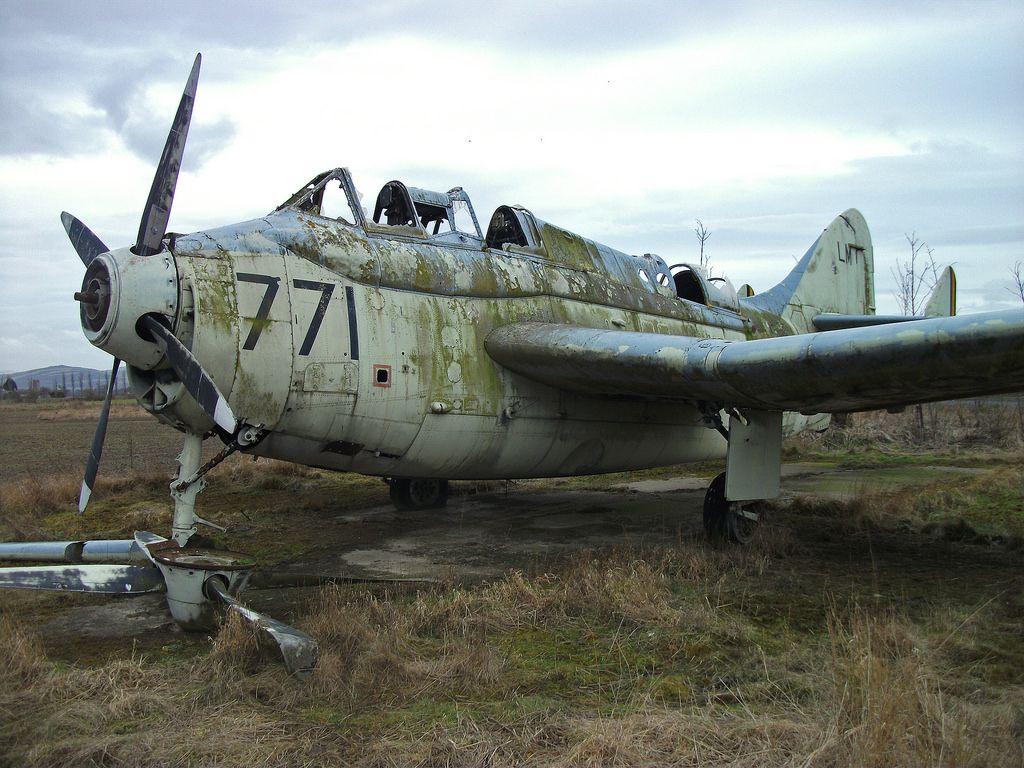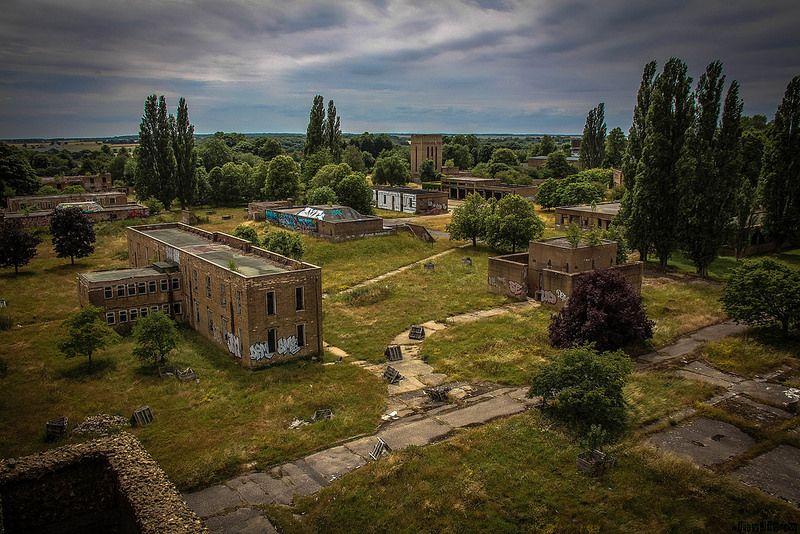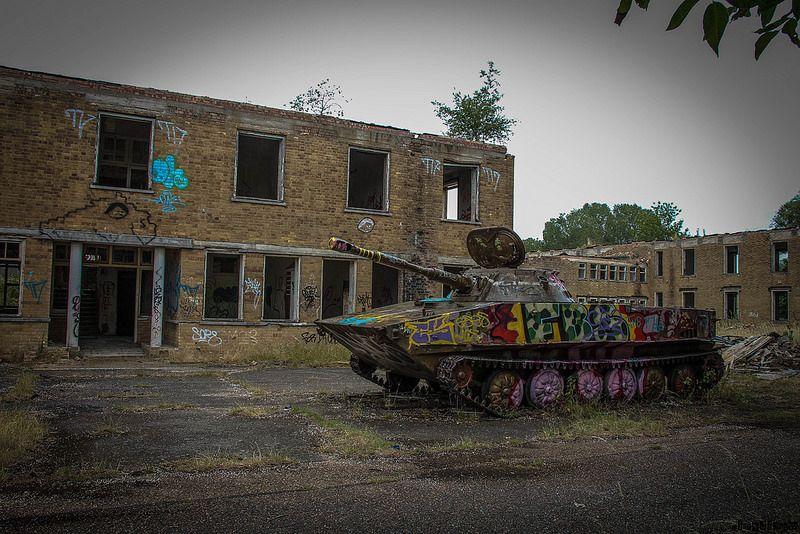![inside-abandoned-raf-upwood-world-war-two-base]() (Image: Dirty Jigsaw; abandoned RAF Upwood’s derelict wartime buildings)
(Image: Dirty Jigsaw; abandoned RAF Upwood’s derelict wartime buildings)
Regular readers of Urban Ghosts will be familiar with the eerie forms of abandoned British airfields, from disused Cold War bases in England and the closed bases of RAF Germany to Britain’s forgotten Fleet Air Arm stations and Coastal Command establishments.
This article documents in pictures the ruins of an expansion period airfield in Cambridgeshire, which closed in 2012 after almost a century of service. Today, the abandoned wartime structures of RAF Upwood have the feel of a military ghost town about them, eerie time capsules evoking the decaying spirit of a turbulent period in our recent history.
![inside-abandoned-raf-upwood-world-war-two-base-2]() (Image: Dirty Jigsaw)
(Image: Dirty Jigsaw)
The abandoned airfield is now poised for redevelopment and some areas have already been repurposed. But despite this, much of what remains resembles a post-military wasteland where the lonely, empty shells of old wartime structures endure. This article charts the history of the now abandoned RAF Upwood, alongside a compelling series of photographs which reveal the airfield’s current state of decay.
Origins of RAF Upwood: World War One
![inside-abandoned-raf-upwood-world-war-two-base-5]() (Image: Dirty Jigsaw)
(Image: Dirty Jigsaw)
Situated seven miles north of the Cambridgeshire market town Huntingdon, RAF Upwood has a fascinating and varied history that dates back almost 100 years. The station was opened as a Royal Flying Corps aerodrome in 1917, when 160 acres of farmland was requisitioned outside Upwood village. Despite having no permanent flying units, it wasn’t long before the BE.2 biplanes of No. 75 Squadron were using the grass field as a night-landing ground.
![inside-abandoned-raf-upwood-world-war-two-base-13]() (Image: Dirty Jigsaw)
(Image: Dirty Jigsaw)
The station that would become RAF Upwood initially served as a satellite airfield for Elmswell, a nearby RFC aerodrome across the county boundary in Suffolk, and by the summer of 1918 was equipped with five rudimentary hangars and a series of huts. Nos. 190 and 191 (Night) Training Squadrons moved in, but when the First World War came to an end in November 1918, Upwood was returned to the local community and its permanent structures demolished.
The Expansion Period
![inside-abandoned-raf-upwood-world-war-two-base-3]() (Image: Dirty Jigsaw; the ruins of RAF Upwood also house an abandoned tank)
(Image: Dirty Jigsaw; the ruins of RAF Upwood also house an abandoned tank)
After hostilities ceased in 1918, the land on which the abandoned Royal Flying Corps airfield stood was destined to remain peaceful for more than 15 years. But when a major period of airfield expansion gripped Britain from 1934, the site was earmarked for reactivation. By the time war again broke out, RAF Upwood was a major Royal Air Force base with five large C-type hangars, an array of permanent, brick-built operations and support structures, and a network of grass runways.
RAF Upwood During World War Two
![inside-abandoned-raf-upwood-world-war-two-base-4]() (Image: Dirty Jigsaw)
(Image: Dirty Jigsaw)
In 1939, when the German invasion of Poland ignited the fuse of World War Two, RAF Upwood’s resident unit 90 Squadron was soon joined by No. 35 Squadron, operating a mixture of Bristol Blenheim and Avro Anson aircraft. But by April 1940 both had been incorporated into No. 17 Operational Training Unit (OTU), tasked with the difficult and often dangerous role of preparing fledgling aircrews for the rigours of front-line service.
During this period the station didn’t see much combat, and despite coming under Luftwaffe attack in 1940 and 1942, Upwood’s death toll amounted to just one person. All that was set to change, however, when 17 OTU converted to the heavier Vickers Wellington bomber.
Upwood’s damp grass runways weren’t suitable for the heavier bombers, and when the unit moved to RAF Silverstone (now a major UK racing circuit) in 1943, the opportunity was taken to build three expansive concrete runways on the station.
![inside-abandoned-raf-upwood-world-war-two-base-10]() (Image: Dirty Jigsaw)
(Image: Dirty Jigsaw)
With its concrete runways operational, various squadrons and aircraft moved onto the station, including the De Havilland Mosquitoes of 139 Squadron flying pathfinder missions over Nazi Germany, and the heavy Lancaster bombers of No. 156 Squadron. At its height of operations, more than 2,500 people worked at RAF Upwood, with 210 aircrew killed in action while flying from the Cambridgeshire airfield.
However, one of the most notable wartime stories concerning RAF Upwood was that of German spy Josef Jakobs, who was captured by local farmers after parachuting into the area and breaking his leg. Found in possession of a code device, £500 in cash and maps of the RAF base, Jakobs was interrogated by the security services and executed for treachery at the Tower of London in August 1941.
Post-World War Two & the Cold War
![inside-abandoned-raf-upwood-world-war-two-base-6]() (Image: Dirty Jigsaw)
(Image: Dirty Jigsaw)
In the mid-1940s, as peace finally descended on the weary, war-torn continent of Europe, RAF Upwood’s role as a heavy bomber base was destined to continue into the Cold War. The station’s aircraft had played a key role in the repatriation of Allied prisoners of war from overseas at the end of the Second World War. Two decades later, in the 1960s, Upwood came under the control of the newly-former RAF Strike Command, which maintained it for various non-flying duties. But by 1981, the historic expansion period airfield lay all but dormant.
RAF Upwood Under US Air Force Control
![inside-abandoned-raf-upwood-world-war-two-base-7]() (Image: Dirty Jigsaw)
(Image: Dirty Jigsaw)
Since around 1975, many American service personnel working at RAF Alconbury had been living in Upwood’s military houses. From 1981, after the site was vacated by the Royal Air Force, RAF Upwood became a satellite station of Alconbury, administered by the 10th Tactical Reconnaissance Wing.
Contracting services were soon moved to Upwood and the US Department of Defence established a state of the art medical facility at the base, offering out-patient services to American military personnel and their families. Various buildings were repurposed as classrooms for children and plans were put in place for dependents of US service personnel to be evacuated from the airfield should Cold War tensions boil over.
![inside-abandoned-raf-upwood-world-war-two-base-11]() (Image: Dirty Jigsaw; decommissioned medical facilities at the abandoned RAF Upwood)
(Image: Dirty Jigsaw; decommissioned medical facilities at the abandoned RAF Upwood)
Thankfully that never happened and, in 1995, as operations at RAF Alconbury were gradually wound down following the collapse of the Soviet Union, RAF Upwood was returned to British control. In 1999 much of the site’s former military housing was refurbished for private ownership. By 2012, Upwood’s medical facility had closed its doors for the last time.
The Abandoned RAF Base Today
![inside-abandoned-raf-upwood-world-war-two-base-8]() (Image: Dirty Jigsaw)
(Image: Dirty Jigsaw)
Seen from the air, the abandoned RAF Upwood seems quiet, its vast concrete runways slowly returning to farmland. But thanks to a local gliding club, Air Training Corps branch and a company called Turbine Motor Works, Upwood’s aviation connections have not been severed. The latter is in the process of establishing a cutting-edge maintenance facility for jet engines at the site, and has set up shop in Upwood’s cavernous expansion period hangars.
![inside-abandoned-raf-upwood-world-war-two-base-9]() (Image: Dirty Jigsaw; some abandoned areas are used for paintball scenarios)
(Image: Dirty Jigsaw; some abandoned areas are used for paintball scenarios)
Similarly, a living history event is held on the abandoned airfield each year, reviving the sights and sounds of the 1940s. But despite these ongoing activities, many of RAF Upwood’s former barracks, operations and support buildings stand eerily abandoned. As this series of urban exploration photographs reveal, vast swaths of the abandoned military base are like a haunting time capsule where the uneasy ghosts of World War Two and the Cold War have not quite faded into history.
![inside-abandoned-raf-upwood-world-war-two-base-12]() (Image: Dirty Jigsaw)
(Image: Dirty Jigsaw)
Related – 10 Abandoned International Airports of the World
The post RAF Upwood: Exploring the Modern Ruins of an Abandoned RAF Base appeared first on Urban Ghosts Media.
 (Image: Simon Iglesias; Panavia Tornado ZA361 in Barcelona, Spain)
(Image: Simon Iglesias; Panavia Tornado ZA361 in Barcelona, Spain)






















































































































